This week is Polly / Oliver week (also Tax week, T-Shirt week, get-that-darn-car-sorted week, and plan-next-semester’s-schedule-week), and I’m working on it like mad.
As a bit of a Hudson-Bay start after my little meltdown/epiphany over the weekend, (or really, a Hudson-Bay Start after a 5 year delay in getting this enterprise off the ground), I took stock of what I had, re-looked for inspiration, and have finally sorted out what I’m actually going to do, and what is actually going to work.
I started with late 18th century female dress borrowed from male hunting attire and military uniforms, some real, some rather satirical:
This print shows an outfit almost identical to the one on the cover of Monstrous Regiment, but for women:
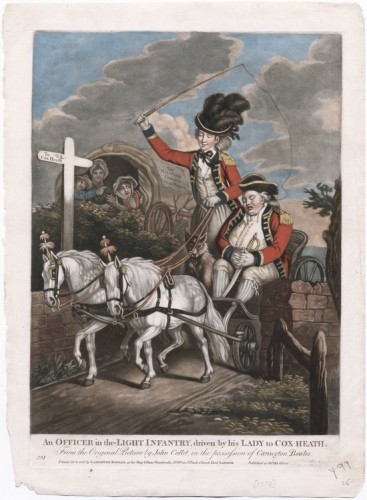
Collett, “Officer in the Light Infantry,” 1770
I’ve already shown you this image:

Dighton, Robert, October 1784 – this plate was also published with the outfit in reversed colours, with a red jacket, and a blue skirt
And, of course, the MA portrait in hunting attire:
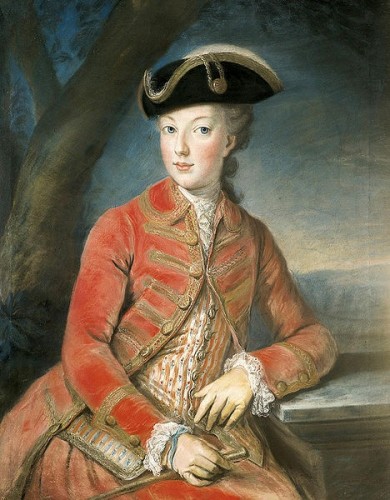
Archduchess Maria Antonia of Austria, the later Queen Marie Antoinette of France, at the age of 16 years, 1771
Finally, the ubiquitous Reynold’s portrait of Lady Worsley:

Sir Joshua Reynolds, Lady Worsley. 1776
From these, I really love the white single-breasted waistcoat on Lady Worsley and the “Officer in the Light Infantry”, and their black feathered hats. I’m also borrowing the gold binding/ edge trim on the jacket of Dighton’s October print, and the gold trim on Marie Antoinette’s jacket. Plus I’m taking elements from the overall shape of Lady Worsley’s and October’s jackets.
So that’s my 18th century inspiration, but how to re-interpret it to the 1880s?
I’d started out with this 1880s Worth walking dress from the Metropolitan Museum of Art as my main inspiration garment, and the jacket I cut out in 2008 is based heavily on it.

Walking dress, House of Worth, ca. 1885 Metropolitan Musuem of Art
However, the more I look at it, the less right it seems.
The lace front? For a military outfit, even a dress one? Ridiculous.
And the long overskirt train? Beautifully reminiscent of late 18th century redingotes, yes, but stupid as a military outfit. Even if I really stretch dress uniform to the fullest, the redingote train effect wouldn’t work for Polly unless I had enough of the red jacket fabric (which I don’t!), or found I beautiful red and white stripe (which, in 5 years of looking, I haven’t).
So, back to the inspiration drawing board, and a scroll through my 1880s favourites folder unearthed this:
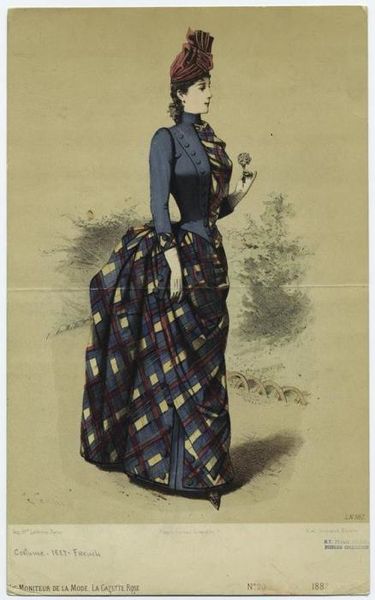
Walking dress, 1887
Walking length skirt? Check. Different coloured skirt and jacket? Check. Place to pull in a tiny bit of jacket fabric on the skirt (because that’s all I have)? Check. 3/4 length sleeves? Check. Opportunity for crazy gold buttons? Check. Overall crisp, military, but very feminine look? Check! And check out the pocket hidden under her hand!
Skirt (and a bit of the jacket) inspiration sorted!
Heck, I may even use something from that daft hat!
(I still totally intend to make this outfit exactly as it is – just waiting for the right fabric).
Now, for the rest of the jacket, I found this image:
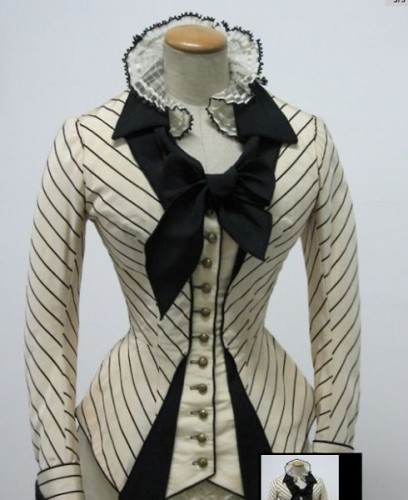
Striped jacket. Is it a movie costume?
The false waistcoat effect is perfect. Unfortunately the image came with no information whatsoever. I don’t think it is an original item. Perhaps a movie costume? Anyone recognise it? A google image search has turned up nothing.
Never fear though, I have lots of proper historical inspiration for the false white waistcoat, like this beauty:
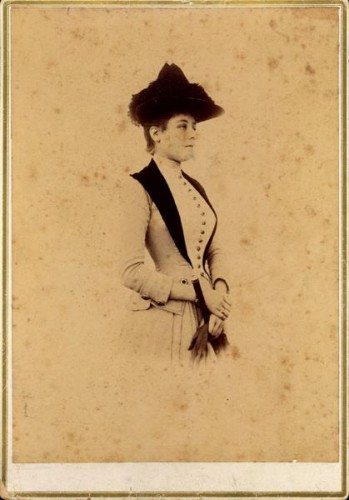
Photo of a woman, ca 1883-90
To pattern up the waistcoat, I put my old jacket pieces back together, draped a front to go under the curved jacket front piece, and sewed it to the back of the jacket to fit it:
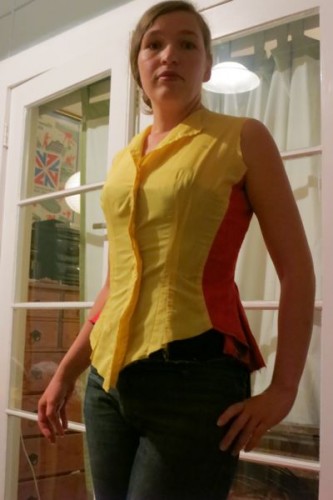
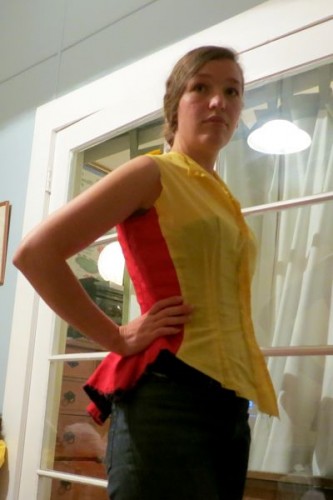
Excuse the terrible photos – I was more interested in sewing than getting pretty pictures! And fear not, the real thing will NOT be bright yellow, and I’ve fixed the teeny fit issues.
In other progress, I’ve decided to go with ivory cotton sateen as my skirt fabric. I draped it and the linen over a chair for a couple of days and considered them both, and decided that the linen was just too, too white, and entirely the wrong look. Also, Fiss massively prefers the cotton, and one should always defer to one’s sewing cat in matters of fabric choice:
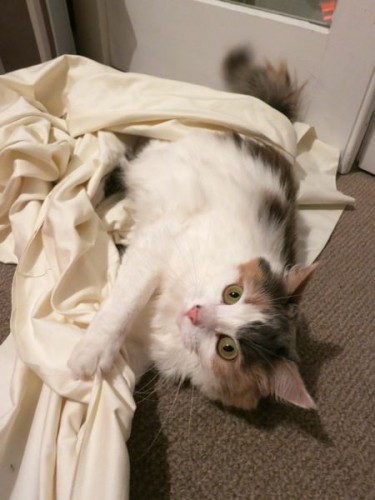
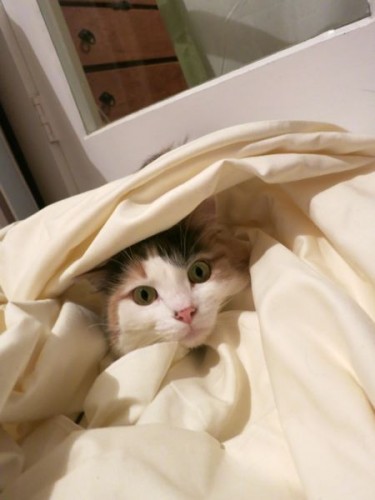
So, lots sorted, but I had one last niggling worry. How to include all that gold in an 188os jacket without it looking like a costume?
Then I found this image, and I had a little epiphany:
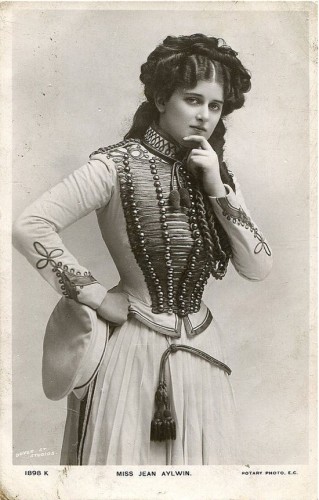
Actress Jean Aylwin in military inspired costume, possibly for ‘The Girls of Gottenburg” ca 1907
Why can’t my outfit be a costume? If I just think of it as an 1880s stage or fancy dress costume, then I can have all the gold I want, it will be true to the book, and historically plausible!
Happy dance! Off to sew!

There is so much to consider even before sewing begins. I am glad you found your Felicity approved fabric. (Miss Fissy is looking gorgeous as ever by the way).
Looking forward to the finished outfit. I do hope Sir Pratchett gets to see it.
This is all looking really good! There is indeed nothing to stop your outfit from being a costume of a costume, as it were. Happy days.
I have one black ostrich feather you are welcome to. Smallish, but puffly.
To support your final idea (final sentence) I would say yes! When I read your mishap post I googled the book and looks like it is a fantasy? I was thinking, when I saw that, that you can be much more free with things, with historical undertones. That is how fictional costuming goes. But I hesitated to say anything since I knew how badly you wanted more historical accuracy and I had a feeling you’d find a way. =) Either way I know you will =) but just to encourage you along, certainly go with your idea. I’ve studied a lot of historical regimentals for my son and they did like all that decorating on the military coat fronts so anything you do of that would be, I think, the key to helping anyone think of it as historically military inspired.
Laurie
The black and white striped bodice is from Tirelli Costumi. It was in Anna Karenina.
Love that last image!
As noted, the white with black stripes is from the 1997 Anna Karenina, there are many lovely costumes in that movie, btw, it’s well worth a view.
Such fun to do Victorian-doing-another-era, looking forward to seeing this come together.
Thank you Andrew! I thought it looked like their work, and it explains why I haven’t seen it. Not a big AK fan. They just spend too much time being emotional and sorry for themselves!
http://periodmoviecaps.blogspot.com/2011/08/annas-white-black-striped-racing-dress.html
Has a few more images of the costume, including stills from the movie. (And a link to a page with more 1997 AK costume photos/stills)
I’ve read a good deal of Pratchett and am very fond of Monstrous Regiment. It’s a satire, yes? If you didn’t go over the top with ridiculosity, you’d be taken for one those terribly serious young things …(speaking as having been one, you know!)
I am so excited for the finished product!
Love the project idea. Trying to combine the historical with Polly’s idealist/pragmatic character is challenge enough, then add in Pratchett’s humour!!
I think the Marie A portrait has it – masculine and military with a hint of frivolity and what a mix of fabrics!. Who doesn’t go all uneccessary at lace over leather? Frogging and a hint of floral?Definitely need a whip….
May I ask what a Hudson Bay start is? I’m unfamiliar with the idiom.
The term Hudson Bay Start comes from the Hudson Bay Company, which controlled the fur trade in Canada from 1660 onwards. When HB fur traders started out on an expedition, they could assume that they would be away for months at a time, in dangerous wilderness, with no chance or rescue or re-stocking, so having the right supplies, and planning properly, was of tantamount importance. To check that they were prepared, they would only journey a short distance on the first day of the expedition – meaning that they would catch any bits and pieces they hadn’t packed, and identify any weaker members of the party, before they had ventured too far from the base to move back. So a Hudson Bay start means you venture a little in to your project, and then stop and take stock before you are too invested.